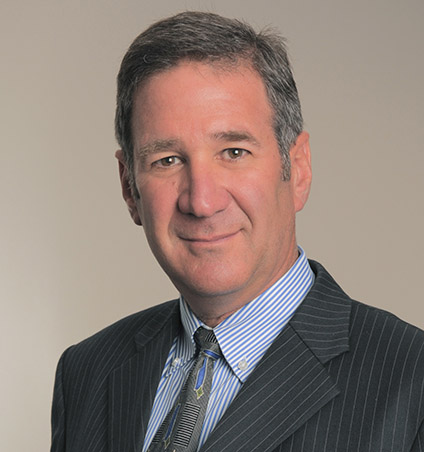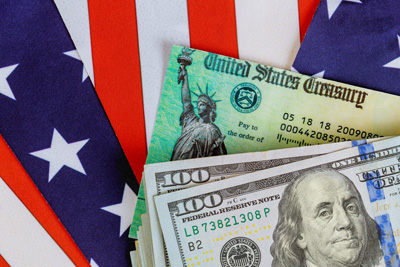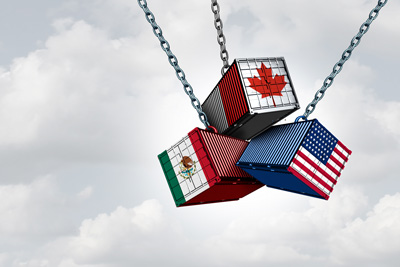Charting the Course
Trumponomics 2.0: (aka “Move Fast and Break Things”)
By Mitch Siegler, Senior Managing Director

If, after the first weeks of the Trump administration, you’re feeling like you’ve been riding a bucking bronco (or maybe you feel like the horse that’s been ‘ridden hard and put away wet’), you’re not alone. Plenty of corporate executives, investment managers and foreign leaders also feel whipsawed.
Generally, reading the macroeconomic tea leaves is part art and part science. Nowadays, it’s a bit of a random walk. To quote Gerard McDonald, economist at 22v Research, “Anyone not plugged directly into the new administration will have difficulty assessing the macroeconomic outlook because policy shocks are likely to be dominant here.”
Exhibit “A”: Treasury Secretary Scott Bessent has set an ambitious “3-3-3” plan, including cutting the deficit in half to 3% of GDP, boosting real economic growth to 3% and boosting U.S. domestic oil production by three million barrels per day. May it come to pass! If we stretch the limits of our imaginations on the latter two goals, it still takes a giant leap of faith to buy into the first one – even if Elon Musk and his Department of Government Efficiency (DOGE) hit it out of the park with cost-cutting. (While we would all like to see fiscal prudence, slashing the deficit by 50% – in the near term, not in out years, as is the usual D.C. budgeting game – is ambitious for anyone who knows the first thing about how the sausage is made in Washington. We’ll unpack this further in a bit.)
While we can’t possibly assess all the moving parts in the economic maelstrom that is the first few weeks of the Trump administration, here are a few thoughts about several major economic factors – the Federal budget deficit, economic growth, energy, interest rates, tariffs, taxes and immigration.
Federal Budget Deficit – the CBO projects the deficit will total 6.2% of gross domestic product (GDP) in 2025, shrink to 5.2% by 2027 and climb again to 6.1% by 2033. (These projections are founded on optimistic assumptions, like no recession during the next decade; some economists feel a recession could be just on the horizon.)
 So, how realistic is it to cut the deficit in half? (Spoiler alert: not very.) In 2023, the U.S. government spent $6.2 trillion, with $1.7 trillion on discretionary spending, $3.8 trillion on mandatory spending (entitlements like Social Security and Medicare), and $659 billion on net interest. So, there’s little we can do about 61% of the spending. And, the 10-year treasury bill, an average of 3.87% in 2023, sits at 4.58% today – nearly 20% higher. So, that $659 billion in net interest would have been more than $100 billion higher with today’s higher interest rates. If the deficits grow, the Treasury will need to boost interest rates, perhaps by a lot, to sell the bonds. Only about 25% of the government spending pie – the discretionary piece – is up for grabs by DOGE – and that’s before we talk about potentially higher interest rates (more on that below).
So, how realistic is it to cut the deficit in half? (Spoiler alert: not very.) In 2023, the U.S. government spent $6.2 trillion, with $1.7 trillion on discretionary spending, $3.8 trillion on mandatory spending (entitlements like Social Security and Medicare), and $659 billion on net interest. So, there’s little we can do about 61% of the spending. And, the 10-year treasury bill, an average of 3.87% in 2023, sits at 4.58% today – nearly 20% higher. So, that $659 billion in net interest would have been more than $100 billion higher with today’s higher interest rates. If the deficits grow, the Treasury will need to boost interest rates, perhaps by a lot, to sell the bonds. Only about 25% of the government spending pie – the discretionary piece – is up for grabs by DOGE – and that’s before we talk about potentially higher interest rates (more on that below).
Economic Growth – The U.S. economy continues to perform much better than most developed nations, owing to our strong positions in the technology and services sectors. The fourth quarter 2024 U.S. quarter-over-quarter growth rate – 2.3% – was down by almost one-third from the third quarter level of 3.2%. Harkening back to the Treasury Secretary’s 3.0% growth goal, we need to boost growth by about one-third from the prior quarter and sustain it at that level to achieve his objective. It’s possible, sure, but it’s no layup.
Compared to Europe, however, the U.S. is a bright, shining star; European growth plummeted from 3.4% in 2022 to just 0.8% in 2023 (and is expected to be basically flat in 2024. In isolation, improved economic growth is certainly achievable but stay with us for a bit for a perspective on how other puzzle pieces – like interest rates and inflation – could impact growth.
Energy – President Trump sums up the new administration’s energy policy in three words: “drill baby drill”. We’re all for clean air and water and the U.S. needs to balance environmental considerations with energy independence, which could reduce gas prices and inflation. It could also provide important intangible benefits (especially vis a vis two major adversaries, Russia and Iran). A balanced approach acknowledges that shifting the economy away from fossil fuels toward solar/wind and electric-powered vehicles is easier said than done since our modern economy is the product of centuries of fossil fuel use. Any energy transition will require investment and occur over time.
Interest Rates – Higher interest rates are a key risk to sustained progress on reducing the Federal budget deficit. Higher rates also pose risks for the bond market, equities, real estate and capital investment. Just a couple of months ago, the vibe was that we would see several interest rate cuts in 2025. In the current ‘higher for longer’ environment, we may see very few – or no – cuts this year. Some, like Ray Dalio, the founder of Bridgewater Associates, the world’s largest hedge fund, is concerned about the implications of U.S. debt levels, which he likens to plaque in the arteries. Eventually, excessive debt becomes constricting, squeezing out other spending and leading to the equivalent of a financial heart attack. Prior to that happening, investors catch on, selling bonds – which can lead to higher, even much higher, interest rates. Suffice to say that the interest rate environment – and forecast – is quite uncertain.
 Tariffs – Trump’s blunt force tariff threats are sending leaders in Canada and Mexico into a tizzy. The threat of tariffs could also have major implications for trade with China and could serve to bring Panama and Denmark (Greenland is an autonomous Danish territory) to the bargaining table. The threat of tariffs creates uncertainty, like forcing U.S. companies to stock up on inventory to safeguard against further supply chain disruptions. That sucks up precious working capital and is a distraction for management. (Of course, tariffs are a boondoggle for lobbyists, who are hard at work seeking exemptions for their clients.)
Tariffs – Trump’s blunt force tariff threats are sending leaders in Canada and Mexico into a tizzy. The threat of tariffs could also have major implications for trade with China and could serve to bring Panama and Denmark (Greenland is an autonomous Danish territory) to the bargaining table. The threat of tariffs creates uncertainty, like forcing U.S. companies to stock up on inventory to safeguard against further supply chain disruptions. That sucks up precious working capital and is a distraction for management. (Of course, tariffs are a boondoggle for lobbyists, who are hard at work seeking exemptions for their clients.)
On Sunday, February 2, tariffs of 25% on all imports were threatened against Canada and Mexico; these were postponed for 30 days after Canada’s Trudeau and Mexico’s Sheinbaum promised to take meaningful steps to tamp down the flow of fentanyl and strengthen border patrols to limit illegal immigration. Our heads are spinning.
Most Americans understand that the President is likely using the threat of tariffs to negotiate with nations he perceives use unfair trade practices (or, in his words, “are ripping us off”). Raymond James economist Eugenio Aleman thinks “the Trump administration is using tariffs as a negotiating tool and while they’re not going to be as bad as many think, there is a risk of overdoing it.” (As an aside, Aleman sees a 40% risk of a recession this year.)
What’s not always acknowledged is that the countries impacted can reciprocate with their own tariffs at the stroke of a pen, leveling the playing field. Less often discussed is that businesses make investment decisions when they have confidence in the future. Uncertainty – like about how tariffs may impact global trade or economic growth – diminishes confidence and investment. If you’ve studied the past few centuries of global trade or read Adam Smith’s “The Wealth of Nations”, you’ll know that trade adds to choices and prices are lower when each country excels at what it does best. From our perspective, implementing wholesale tariffs would be madness. Very few things can be inflationary and recessionary at the same time, but tariffs are one of them. (All that said, China has been violating trade rules and intellectual property norms for eons so tariffs on certain Chinese goods may be appropriate.)
Taxes – Understanding the likely corporate and individual tax rates, what’s deductible and exempt from tax is key in providing business leaders and investors clarity to make wise decisions. Earlier, we touched on the Federal budget deficit, which is around 6.2% of GDP. If Congress extends the Trump tax cuts, U.S. government debt would jump to about 7.5% of GDP, according to the Congressional Budget Office. Both are way too high since the debt must be sold to buyers in the rest of the world; they’re wary given how much U.S. debt they currently have, because of the threat of tariffs and trade friction and other geopolitical risks. One thing is clear: we have absolutely, positively, no idea where any of this is heading today so we’ll await further clarity before wading deeper into the tax waters.
Immigration – The President has long made immigration a cornerstone of his platform. We need more engineers and scientists and should have more H-1B visas. We also need gardeners, agricultural workers, construction workers, housekeepers and more – it’s unrealistic to slam the door shut on immigration. Polls show that a large majority of Americans believe both that our immigration system is broken, and that uncontrolled, illegal immigration depresses wages and has other negative effects on our society. Americans don’t want to see millions of people who are living, working and paying taxes in this country deported. We welcome sensible, thoughtful and collaborative approaches to these challenges.
There’s a lot to unpack after just a few weeks of the new administration. Buckle up – it could be a wild ride.
Mitch Siegler is Senior Managing Director of Pathfinder Partners. Prior to co-founding Pathfinder in 2006, Mitch founded and served as CEO of several companies and was a partner with an investment banking and venture capital firm. He can be reached at msiegler@pathfinderfunds.com.
Share this Article
IN THIS ISSUE
PATHFINDER MULTIFAMILY OPPORTUNITY FUND IX, L.P.
CHARTING THE COURSE
Trumponomics 2.0: (aka “Move Fast and Break Things”)
FINDING YOUR PATH
The Chickens are Coming Home to Roost
GUEST FEATURE
Early Lessons from the L.A. Fires
ZEITGEIST
News Highlights
TRAILBLAZING
Casa Madrid, Chula Vista (San Diego), CA
NOTABLES AND QUOTABLES
Diligence
